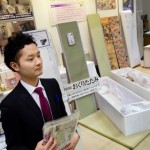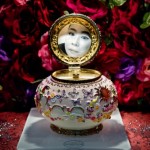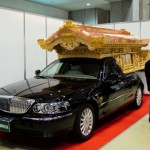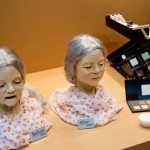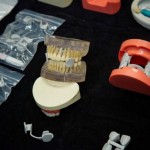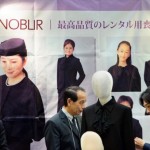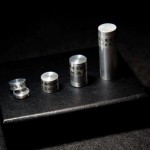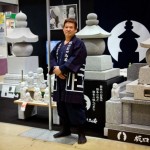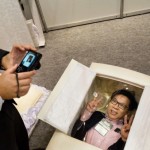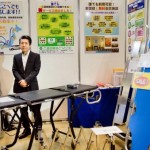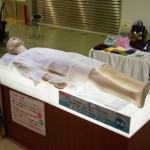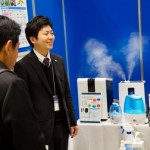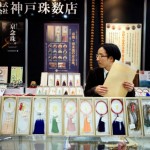In rapidly aging Japan, dying is big business
At Tokyo’s Life Ending Industry Expo, companies touted products for the $41 billion industry in end-of-life planning and memorials.
By Anna Fifield
Traditional statuary and memorials were among the products on offer. In Japan, death is an opportunity for growth. Business growth, that is.In a country with many more deaths than births each year, Japanese companies are looking to maximize the amount of money people spend on shuffling off their mortal coil, from preparing “ending notes” and choosing coffins to arranging to have their ashes blasted into space or turned into diamonds.
“I want to promote our products because we have almost 1.2 million people dying each year but we sell only 60,000 of these mats,” said Koichi Fujita, a representative of a company selling tatami liners and pillows for coffins. He was using slightly outdated death figures: Japan said goodbye to 1.3 million citizens last year but hello to only 1 million new babies.
Fujita’s was one of the scores of companies touting their wares at Endex, an expo devoted to planning for the end of one’s life, held at a huge exhibition center in Tokyo.
“Japanese people spend their lives on tatami mats,” Fujita said, referring to the straw flooring in traditional Japanese rooms. “And there’s a saying that they want to die on a tatami mat, meaning die at home. But so many people die in the hospital, so at least they can have a tatami mat in their coffin when they are sent off.”
Japan has the fastest-aging population in the world. Slightly more than one-quarter of the population is 65 or older, and the Health Ministry forecasts that the proportion will hit 40 percent by 2060.
Many aspects of Japanese life are now geared toward senior citizens. Go into any drugstore and you will find shelves of diapers and sippy cups — for the elderly. Banks and post offices have reading glasses on the counters for customers with failing eyesight, while big pedestrian crossings have buttons to push for those who need extra time to get across the road.
Panasonic has a line of easier-to-use household appliances — including washing machines, microwaves and rice cookers — targeted at the elderly, while convenience stores sell packaged food in smaller portions for seniors.
But the business of actually dying is a whole other opportunity. There is even a term for it here: “shukatsu,” or preparing for death. It is a play on a more common homophone for job-hunting.
“The government estimates that in 2038, 1.68 million people will die,” said Midori Kotani, a social scientist at the Dai-ichi Life Research Institute, part of a major insurance company. “Because there are so many more people dying, people see business opportunities there.”
At the first Endex, or “Life Ending Industry Expo,” more than 200 companies were trying to get a bigger chunk of the industry, which the expo’s organizing committee said was now valued at a whopping $41 billion.
There were the usual coffins and tombstones, plus the latest-model hearses. But there were also Buddhist monks touting for business — people are not keeping up with the annual rituals these days — and coffee retailers hoping to sell their products as gifts for funeral attendees, which is a custom here.
There was also a mobile pet cremator offering to pull up his furnace-loaded van in front of your apartment building and turn Fido into ash. A 20-pound dog costs about $300 and takes about an hour to cremate. A hamster, considerably less on both counts.
There were also some novel products for humans.
“Some people have long wanted to go into space,” said Hirohisa Deguchi of Galaxy Stage, a company that will send a small metal container of ashes up in a rocket. (Funnily enough, his surname means “exit.”) “We can put them in this capsule and launch them on a rocket.”
Five people have had some of their remains sent into space, and another five are scheduled for liftoff next month .
[With rural Japan shrinking and aging, a small town seeks to stem the trend]
The cheapest “space memorial” — being launched into space and burning up on reentry — costs about $3,700, or you can go into orbit on a satellite, where your family can track you with GPS for 240 years, for $8,000. The deluxe model — having your ashes left in a capsule on the moon — costs an out-of-this-world $21,000.
For those who want to stay on the ground, the Heart in Diamond company offers to turn a person’s hair or ashes into a gemstone. The company offers a range of colored diamonds — including orange, blue and green, in various sizes and carats — starting at $3,000 and going up to $20,000.
Most customers are women wanting to keep their mothers close, said Naoto Kikuchi, a company director, as he manned his busy stall.
There is a special reason this “mourning jewelry” appeals to Japanese women, he said: “If you’re married, you are buried with your husband’s family, not with your own family.” That makes jewelry a way to keep your birth family close, he said.
But there is another reason people in the shukatsu business need to innovate: Even as the number of deaths goes steadily up, the money that people spend on funerals and other such expenses is going steadily down. That means the overall industry is stagnant, said Kotani, of the Dai-ichi institute.
“In a place like Tokyo, about 30 percent of people who die don’t even have funerals — they just go straight to cremation. Plus, how much people spend on one funeral is declining,” Kotani said, adding that people are becoming increasingly frugal and are not wanting to cause stress for their families left behind.
“So people in this business have to find ways to maximize the amount of money spent on each death,” Kotani said. “That’s why we’re seeing video messages from deceased people and offers to send ashes into space.”
One of the 22,000 people who were checking out the options at the expo was Mariko Saito, a 68-year-old widow from Tokyo. “I learned about this on television,” she said as she perused small Buddhist urns.
“I don’t want to be buried in the same grave as my [deceased] husband as I don’t have a good relationship with his side of the family,” she said with a laugh. “So I’d like to think about what I want to do with my money and about my ending and share it with my daughter when she visits for New Year’s holidays.”
For businesses, there is a strong incentive to cater to people such as Saito, to be innovative and come up with new ways to make money. As Kotani puts it, “After all, you only die once.”
Complete Article HERE!

